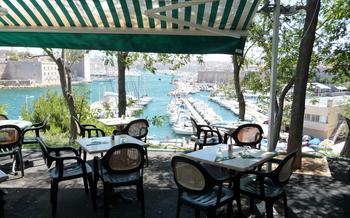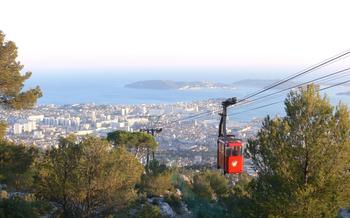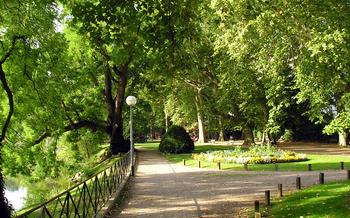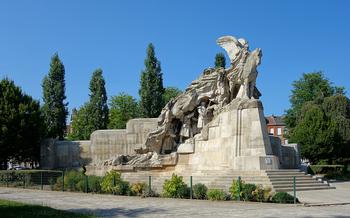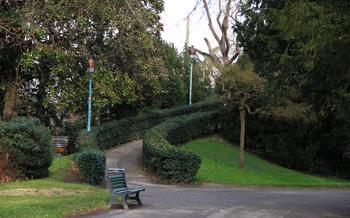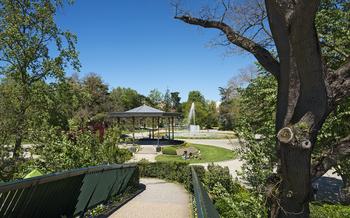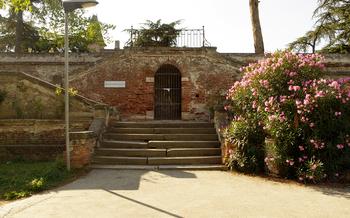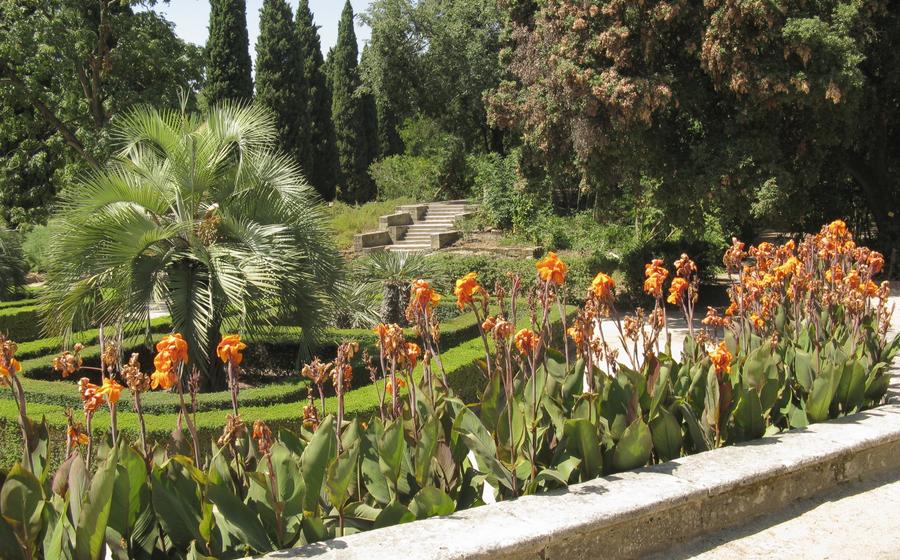
Botanical Garden of Montpellier
- Exploring the Diverse Plant Collections
- Educational and Interactive Displays
- A Haven for Wildlife
- Seasonal Highlights
- The Garden's Historical Significance
- Art and Nature Intertwined
- A Place for Relaxation and Reflection
- Picnics and Refreshments:
- Events and Workshops:
- Accessibility and Inclusivity:
- Sustainability and Conservation Initiatives
- Photography and Social Media
- Getting There and Around
- Insider Tip: Unveiling Hidden Gems and Unique Experiences
Exploring the Diverse Plant Collections
The Botanical Garden of Montpellier offers a diverse array of plant collections, showcasing a wide range of species from around the world. Visitors can explore specialized sections dedicated to specific plant groups, each presenting a unique perspective on the plant kingdom.
One highlight is the Mediterranean Garden, a vibrant display of plants that have adapted to the region's unique climate. Here, visitors can admire aromatic herbs like lavender and rosemary, as well as drought-tolerant succulents and cacti.
Another must-see is the Japanese Garden, a serene oasis inspired by traditional Japanese gardening principles. This section features a picturesque pond, meticulously arranged rocks, and a variety of native Japanese plants, creating a tranquil and contemplative atmosphere.
The garden also boasts an impressive collection of rare and endangered plants, contributing to conservation efforts and preserving biodiversity. Visitors can learn about the importance of these threatened species and the vital role they play in maintaining ecological balance.
Additionally, the garden features thematic gardens that cater to specific interests. The Rose Garden, for example, showcases a dazzling array of roses in various colors and fragrances, while the Alpine Garden presents a collection of plants that thrive in mountainous regions.
Throughout the garden, interactive signage and educational displays provide visitors with detailed information about plant species, their origins, and their significance. Guided tours led by knowledgeable botanists offer a deeper dive into the garden's diverse collections, tailoring the experience to different interests and levels of expertise.
Educational and Interactive Displays
The Botanical Garden of Montpellier is not just a showcase for beautiful plants; it's also a hub of education and interactive engagement. Visitors can delve into the world of botany through a variety of interactive exhibits and signage that provide fascinating insights into the plant species, their origins, and their significance. Knowledgeable botanists lead guided tours tailored to different interests and expertise levels, offering a deeper understanding of the garden's diverse flora. For children and families, the garden hosts engaging workshops and educational programs that foster an appreciation for nature and its wonders. These initiatives make the Botanical Garden of Montpellier an ideal destination for learning, exploration, and discovery.
A Haven for Wildlife
The Botanical Garden of Montpellier is not only a showcase for diverse plant life but also a haven for local wildlife. Its diverse habitats, ranging from ponds and streams to woodlands and meadows, provide a sanctuary for a variety of animal species. Birds, insects, and reptiles thrive within the garden's ecosystem, contributing to its ecological balance and biodiversity.
The garden's ponds and streams are home to a variety of aquatic creatures, including frogs, newts, and dragonflies. The lush vegetation along the water's edge provides shelter and breeding grounds for these amphibians and insects. The garden's woodlands and meadows, with their diverse plant species, offer habitat and food sources for a variety of bird species, including warblers, finches, and woodpeckers.
The garden's reptile population includes lizards, snakes, and turtles. These creatures play an important role in the ecosystem by controlling insect populations and dispersing seeds. The garden's staff is committed to promoting biodiversity and creating a sustainable ecosystem within the urban environment. They work to maintain a balance between the different species and to minimize the impact of human activity on the garden's wildlife.
By providing a refuge for local wildlife, the Botanical Garden of Montpellier contributes to the preservation of biodiversity and the well-being of both wildlife and humans. It serves as a reminder of the importance of protecting natural spaces, even within urban areas, for the benefit of all living creatures.
Seasonal Highlights
The Botanical Garden of Montpellier is a living tapestry that transforms with the changing seasons, offering a kaleidoscope of colors and scents throughout the year.
Spring
Spring awakens the garden with a vibrant display of blooming magnolias, cherry blossoms, and tulips. The air is filled with the heady fragrance of hyacinths and daffodils, creating a sensory feast for visitors. This is the time to witness the garden's metamorphosis from winter slumber to a riot of colors, as new life bursts forth in every corner.
Summer
As summer's warmth envelops the garden, roses of every hue unfurl their petals, filling the air with their intoxicating perfume. Lavender fields bloom in vibrant purple, attracting bees and butterflies, while Mediterranean herbs, such as thyme, rosemary, and sage, release their aromatic oils, creating a fragrant oasis.
Autumn
Autumn brings a golden glow to the garden as the leaves of deciduous trees turn into a tapestry of warm hues. The ripening fruits of the orchard, such as apples, pears, and figs, add a touch of sweetness to the changing landscape. This is the time to savor the last blooms of the season, such as dahlias, chrysanthemums, and asters, before the garden prepares for winter's rest.
Winter
Even in the depths of winter, the garden retains its charm with evergreens, camellias, and seasonal decorations. The bare branches of trees create intricate patterns against the winter sky, while the serene atmosphere invites visitors to pause and reflect amidst nature's tranquility. This is the time to appreciate the subtle beauty of winter-blooming plants, such as hellebores, snowdrops, and winter aconites, which brave the cold to bring color to the garden.
The Garden's Historical Significance
The Botanical Garden of Montpellier has a rich history dating back to the 16th century. It was founded in 1593 by Pierre Richer de Belleval, a physician and botanist who recognized the importance of a botanical garden for teaching and research. The garden initially focused on medicinal plants, but over time it expanded to include a wide variety of species from around the world.
In the 17th century, the garden became a center for botanical research under the direction of Pierre Magnol, a renowned botanist who developed a system for classifying plants that is still used today. Magnol's work was instrumental in the development of modern botany, and the garden became a popular destination for botanists and students from across Europe.
Throughout the 18th and 19th centuries, the garden continued to grow and develop. It was expanded to include new sections, such as the Mediterranean Garden and the Japanese Garden, and it became a popular destination for tourists as well as scientists. In 1992, the garden was designated as a historical monument, recognizing its cultural and scientific importance.
Today, the Botanical Garden of Montpellier is a living museum, showcasing the diversity of plant life from around the world. It is also a center for botanical research and education, and it plays an important role in the conservation of rare and endangered plant species.
Art and Nature Intertwined
The Botanical Garden of Montpellier is not only a haven for plants but also a vibrant canvas for artistic expression. Sculptures and art installations are harmoniously placed throughout the garden, creating a captivating blend of nature and creativity. These works of art not only add aesthetic appeal but also stimulate thought and reflection, inviting visitors to contemplate the interconnectedness of art and nature.
Thematic exhibitions and events further showcase the garden as a platform for artistic expression. Local artists are often invited to display their work within the garden's verdant setting, using the natural surroundings as their inspiration. These exhibitions provide visitors with a unique opportunity to appreciate the diverse talents of local artists while immersing themselves in the beauty of the garden.
Visitors are also encouraged to engage in art-related activities during their visit. Sketching and photography workshops are regularly organized, allowing participants to capture the essence of the garden through their own artistic lens. These workshops not only foster creativity but also provide a deeper appreciation for the intricate details and beauty of the plant world.
A Place for Relaxation and Reflection
In the midst of the bustling city, the Botanical Garden of Montpellier offers a tranquil oasis where visitors can escape the hustle and bustle and find a moment of peace and reflection. The garden's serene atmosphere and tranquil corners provide a sanctuary for those seeking relaxation and contemplation. Benches and seating areas are scattered throughout the grounds, inviting visitors to pause and appreciate the beauty of their surroundings. The calming environment of the garden promotes mental well-being and reduces stress, making it an ideal place to unwind and recharge. Whether you're seeking solace in nature's embrace or simply looking for a quiet spot to gather your thoughts, the Botanical Garden of Montpellier offers a haven of tranquility amidst the urban landscape.
Picnics and Refreshments:
Picnicking amidst the beauty of the Botanical Garden of Montpellier is a delightful experience. The garden provides several designated picnic areas, inviting visitors to spread their blankets and enjoy a leisurely meal surrounded by nature's splendor. For those who prefer not to pack their own food, a charming café or tearoom within the garden offers a tempting selection of refreshments and light snacks. Indulge in freshly brewed coffee or fragrant tea, accompanied by pastries, sandwiches, or homemade cakes, while soaking in the tranquil atmosphere of the garden. Additionally, the garden's shop offers a variety of local produce and artisanal products, allowing visitors to purchase unique souvenirs or ingredients to create their own picnic feast. Supporting sustainable agriculture and savoring local flavors adds an extra dimension to the experience.
Events and Workshops:
The Botanical Garden of Montpellier is not just a passive oasis; it's a vibrant hub of activity, hosting a diverse range of events and workshops throughout the year. These events cater to a variety of interests and age groups, offering visitors unique and engaging experiences that deepen their connection with the natural world.
Plant sales and exhibitions are a popular highlight, providing an opportunity for visitors to acquire rare and unusual species and learn about the art of gardening from experienced professionals. Seasonal festivals and themed events add a touch of festivity to the garden, celebrating the changing seasons and showcasing its diverse offerings. Whether it's a spring blossom festival, a summer concert series, or an autumn harvest celebration, there's always something special happening at the Botanical Garden of Montpellier.
Accessibility and Inclusivity:
The Botanical Garden of Montpellier is committed to providing an inclusive and accessible environment for all visitors. Wheelchair-accessible paths meander through the garden, allowing visitors with limited mobility to explore its diverse plant collections. Designated areas offer a serene space for visitors with disabilities to rest and enjoy the garden's beauty. Guided tours and educational programs can be tailored to meet the needs of visually impaired or hearing-impaired visitors, ensuring that everyone has the opportunity to learn about and appreciate the wonders of the plant world. Multilingual signage and materials make the garden welcoming to international visitors, fostering a sense of global community and understanding.
Sustainability and Conservation Initiatives
The Botanical Garden of Montpellier is committed to sustainable practices and conservation initiatives, recognizing its role in preserving the environment and promoting responsible tourism. Rainwater harvesting systems and composting techniques are employed to minimize water usage and reduce waste. Organic gardening practices are followed to maintain the health of the soil and minimize the use of chemical pesticides.
The garden's sustainable lighting system uses energy-efficient LED bulbs, reducing its carbon footprint. Waste reduction programs are in place, including recycling and composting initiatives, to minimize the garden's environmental impact. The garden actively promotes responsible tourism, encouraging visitors to respect the environment and leave no trace during their visit.
Moreover, the garden plays a crucial role in raising awareness about conservation issues and promoting sustainable practices among its visitors. Through educational programs, guided tours, and signage, the garden highlights the importance of biodiversity, habitat protection, and responsible gardening. By showcasing sustainable practices and promoting conservation initiatives, the Botanical Garden of Montpellier sets an example for other botanical gardens and green spaces, demonstrating the harmony between horticulture and environmental responsibility.
Photography and Social Media
The Botanical Garden of Montpellier offers a feast for the eyes, making it a popular destination for photography enthusiasts. With its diverse plant life, colorful blooms, and picturesque landscapes, the garden provides endless opportunities to capture stunning images. Visitors are encouraged to share their photos and experiences on social media, using designated hashtags such as #BotanicMontpellier or #JardinBotaniqueMontpellier. The garden's own social media presence showcases highlights, provides behind-the-scenes glimpses, and engages with visitors, creating a vibrant online community of nature lovers. Whether you're a seasoned photographer or simply enjoy capturing the beauty of your surroundings, the Botanical Garden of Montpellier is an Instagrammer's paradise. Don't forget your camera or smartphone to document your visit and share the beauty of this botanical haven with the world!
Getting There and Around
Reaching the Botanical Garden of Montpellier is a breeze, with multiple transportation options available. For those who prefer public transportation, the city's efficient tram system offers a direct line to the garden. Simply hop on tram line 1 and alight at the "Botanique" stop, which is just a short walk from the garden's entrance. Alternatively, several bus lines also serve the area, providing convenient connections from different parts of the city.
For those arriving by car, the garden offers ample parking facilities. There are two designated parking areas located near the entrance, one on each side of the garden. These parking lots provide ample space for visitors, ensuring a hassle-free arrival. Additionally, there are designated areas for bicycles and electric vehicles, promoting sustainable transportation options.
Once inside the garden, a detailed map is available to help visitors navigate the premises. The map highlights key attractions, such as the different plant collections, thematic gardens, and educational exhibits. This allows visitors to plan their visit efficiently and make the most of their time.
Insider Tip: Unveiling Hidden Gems and Unique Experiences
Beyond the main attractions, the Botanical Garden of Montpellier holds a treasure trove of hidden gems waiting to be discovered. Venture into the secluded Rose Garden, a fragrant haven brimming with vibrant blooms and heady scents. From the panoramic terrace, soak in breathtaking views of the city skyline, the surrounding countryside, and the glistening Mediterranean Sea.
To fully immerse yourself in the garden's wonders, time your visit to coincide with special events or workshops. Experience the magic of the garden under the moonlight during a captivating night tour. Learn the art of botanical illustration in a hands-on workshop, capturing the essence of the plants on paper.
Don't hesitate to engage with the friendly and knowledgeable staff, who are passionate about sharing their insights and recommendations. They can guide you to lesser-known corners of the garden, point out rare or endangered species, and suggest the best times to visit for specific blooms or events. Embrace their expertise to unlock the hidden treasures of this botanical paradise.
